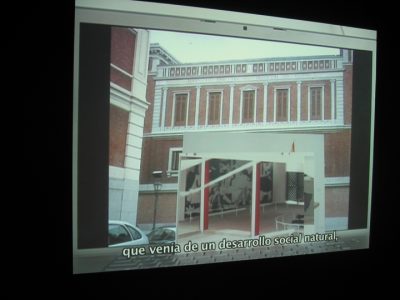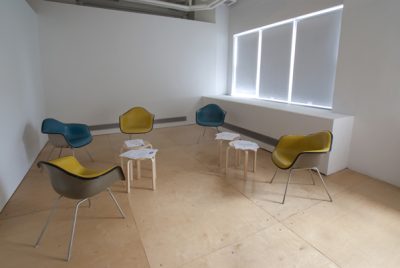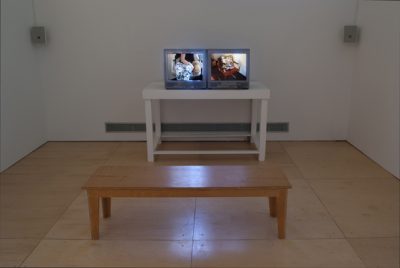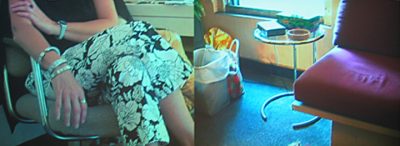Exhibitions
ABOUT THE EXHIBITION
In the exhibition Reflection: a video program, video works by five artists linked by their varying approaches to the artistic agency were shown in succession in the gallery, one artist per day of the week. How do artists conceive of the work they do? How do they picture themselves? Is the proposition of artistic agency a proposition for the individual agency as well? In video works by Phyllis Baldino, Alex Hubbard, Glenn Ligon, Andrea Zittel, and Patricia Esquivias, featuring each artist ’s voice, activity, and milieu, the question of individual responsibility was variously addressed.
In her Gray Area series of works, Phyllis Baldino creates actions with studio and domestic objects. Low-tech and often absurd, the videos document the artist in the process of assembling found objects, taking them apart, reconstructing them, or transforming their function. Typically, the artist’s actions result in oppositions, contradictions or incongruities, revealing ironic gaps between the objects and the meanings assigned to them. The artist is proposed as the means of philosophical disclosure.
Alex Hubbard ’s video Screens for Recalling the Blackout
features studio manipulations of material for the camera. In previous works, the artist who affects these actions is often unseen, but here glimpses of Hubbard can be made out, forcing recognition of the actions on camera as performance, demystifying the gags.
In The Orange and Blue Feelings, Ligon depicts several visits to his therapist. As proposed by Migon Nixon, Ligon’s disturbance of the therapist/patient dynamic intertwines art-making and psychoanalytic transference, asserting a self-reflexive agency that avoids the narcissistic impulse classically attributed to video.
Made in a documentary-like fashion, Andrea Zittel ’s Small Liberties is a sequence of photographs given narration by intertitles that advance the artist’s autonomy as agency. By ostensibly describing her Wagon Station project, Zittel tells a partial history of her own desire to avoid bureaucratic systems, as well as the history and beliefs of the individuals who adapt and personalize Zittel’s Wagon Stations for themselves.
Patricia Esquivias is a storyteller. In a laconic voice, she narrates looping subjective takes on history, proffering for the camera a seemingly improvisational set of photographs, notes, and computer images to weight the story. The informal nature of this proposition of material—presented most typically as the artist’s hand holding a photograph up for the camera—and the artist’s unlikely combination of facts suggest the artist’s storytelling be a model for history-making: a democratic, continuous, permeable and participatory activity.
Reflection’s choice of subject matter and exhibition strategy were born of Gallery 400’s positioning within an educational institution. The intention of the exhibition is for the young artists studying in Art and Design Hall to pause to consider their own positioning as artists.
Reflection: a video program is presented concurrently with Gnathonemus Petersii, HALFULL, and Project #12.
ARTISTS
Phyllis Baldino, Patricia Esquivias, Alex Hubbard, Glenn Ligon, and Andrea Zittel.
SUPPORT
Reflection: a video program is supported by the College of Architecture and the Arts, University of Illinois at Chicago, and a grant from the Illinois Arts Council, a state agency.





